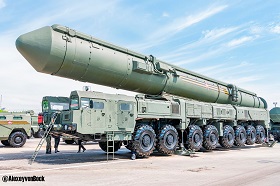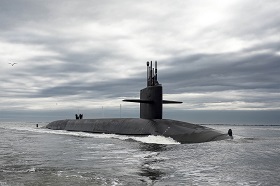In June 2020, the Kremlin published its new Basic Principles of State Policy of the Russian Federation on Nuclear Deterrence. Without going into an in-depth analysis of the document, we will note that “non-nuclear” weapons are named among the military risks that might evolve into military threats requiring nuclear deterrence. Moreover, the term “non-nuclear deterrence” can be found in the current Military Doctrine of the Russian Federation. Let us try to figure out what this is, why it is needed and how it works — if, of course, it works at all.
The Military Doctrine of the Russian Federation defines “non-nuclear deterrence” as a “system of foreign policy, military and military-technical measures aimed at preventing aggression against the Russian Federation through non-nuclear means.”
Based on the comments made publicly by leading Ministry of Defence officials, and of the General Staff in particular, we can ascertain that “non-nuclear deterrence” groupings primarily include missiles of various types: Iskander-M short-range ballistic missiles (both cruise and aeroballistic surface-to-surface missiles), Kalibr family of sea-launched cruise missiles (and Tsirkon hypersonic missiles in the future), and the Kh-555 (AS-15 Kent-C) and Kh-101 (AS-23A Kodiak) long-range air-launched cruise missiles.
The face of non-nuclear deterrence could change dramatically in the next decade. The collapse of the Intermediate-Range Nuclear Forces Treaty and the huge investments in hypersonic weapons over the past few decades promise to alter the military-technical and military-strategic landscape. We can expect the appearance of air-based high-precision hypersonic missiles (initially aeroballistic and then “motorized” hypersonic), the return of now non-nuclear intermediate-range ballistic missiles, and the arrival of ground-based versions of long-range cruise missile systems as mass workhorses that will be able to launch more missiles per salvo at a more attractive price compared to their analogues in the air force and the navy.
Both pop culture and the gloomy forecasts of scientists and military officials paint a more than vivid picture of the “unacceptable damage” that strategic nuclear forces can inflict. Non-nuclear deterrence does not elicit the same kind of emotional reaction, at least in its current form — high-precision cruise missiles have already lost their aura as superweapons and have become just another mass weapon.
Like it or not, the question arises: If hundreds or even thousands of missiles were not enough to force a third-world country to surrender (not to mention the many thousands of airstrikes that were carried out at the same time), then how many are needed to deliver unacceptable damage to a major military power? Or to a bloc of powers that Russia needs to deter first and foremost. You can doubt the decisiveness of the European members of NATO all you like, but if the desire to build up forces to deter the adversary using non-nuclear means is declared, then an unimaginable number of such weapons would be needed.
Non-nuclear deterrence based on primarily forward-based advanced weapons systems and military equipment that are in heightened, if not constant, combat readiness is extremely expensive. At the same time, nuclear weapons have, to some degree, become a "weapon of the poor." Given the fact that the Russian nuclear weapons enterprise and nuclear deterrence forces are in good shape, the gradual “phasing out” of non-nuclear deterrence might seem a reasonable economic measure. A different matter, in this case, is how the nuclear threats will evolve and the sheer scale of resources and efforts needed for the relevant nuclear deterrence forces development.
In June 2020, the Kremlin published its new Basic Principles of State Policy of the Russian Federation on Nuclear Deterrence. Without going into a deep analysis of the document, we will note that “non-nuclear” weapons are named among the military risks that might evolve into military threats requiring nuclear deterrence. What is more, the term “non-nuclear deterrence” can be found in the current Military Doctrine of the Russian Federation. Let us try to figure out what this is, why it is needed and how it works — if, of course, it works at all.
Foreign Experience
In the late 1980s and early 1990s, the United States attempted to build non-nuclear deterrents on the basis of the progress it had made in the development of precision air- and sea-based cruise missiles. The operational deployed Tomahawk and ALCM missiles were successfully used during Operation Desert Storm in 1991. The “hi-tech” nature of these weapons at the time can be somewhat proved by the fact that the B-52G bomber airstrikes using ALCM cruise missiles were only declassified on the first anniversary of the war.
Today, the large American arsenals of air- and sea-based cruise missiles (the mass-produced missiles of the JASSM family that are carried by bombers as well as fighter jets are of particular note here), as well as the Chinese medium-range ground-based ballistic and cruise missiles, and the naval cruise missiles of the People’s Liberation Army Navy, are the classic means of non-nuclear deterrence that best convey the essence of the phenomenon. Several European countries also develop and manufacture their own air-launched cruise missiles, most notably France, which developed its MdCN sea-launched long-range cruise missile on the basis of the SCALP EG (Storm Shadow) air-launched missile that were used on targets in Syria in 2018, albeit with some difficulties. However, the European armed forces do not have enough long-range missiles to play a serious deterrent role.
That said, the face of non-nuclear deterrence could change dramatically in the next decade. The collapse of the Intermediate-Range Nuclear Forces Treaty and the huge investments in hypersonic weapons over the past few decades promise to alter the military-technical and military-strategic landscape. We can expect the appearance of air-based high-precision hypersonic missiles (initially aeroballistic and then “motorized” hypersonic), the return of intermediate-range ballistic missiles (initially non-nuclear this time), and the arrival of ground-based versions of long-range cruise missile systems as mass workhorses that will be able to launch more missiles per salvo at a more attractive price compared to their analogues in the air force and the navy.
Russian Missiles
The Military Doctrine of the Russian Federation defines “non-nuclear deterrence” as a “system of foreign policy, military and military-technical measures aimed at preventing aggression against the Russian Federation through non-nuclear means.”
Both Russian Ministries of Defence and of Foreign Affairs frequently use the phrase “non-nuclear deterrence”, albeit in different contexts. The military seems to be above all focused on demonstrating qualitative and quantitative growth in the field of modern, advanced weapons and military equipment. Meanwhile, for diplomats, the presence of such a concept in the “military lexicon” allows it to be used as an argument against the insinuation that the threshold for using nuclear weapons is lower, and that its role in Russian military thought is not as important as it once was.
Based on the comments made publicly by leading Ministry of Defence officials, and of the General Staff in particular, we can ascertain that “non-nuclear deterrence” groupings primarily include missiles of various types: Iskander-M short-range ballistic missiles (both cruise and aeroballistic surface-to-surface missiles), Kalibr sea-launched cruise missiles (and Tsirkon hypersonic missiles in the future), and the Kh-555 (AS-15 Kent-C) and Kh-101 (AS-23A Kodiak) long-range air-launched cruise missiles.
It is worth noting that, in Russia’s case, the S-400 anti-aircraft missile system, as well as the Bastion mobile coastal defence missile system with Oniks supersonic anti-ship cruise missiles, are sometimes classified as non-nuclear deterrents. This is likely a consequence of the West's apparent concern about Russia's “Anti-Access/Area Denial” capabilities, which consist of effective anti-aircraft and anti-ship defence systems with a range of several hundred kilometres. They are capable of hitting enemy air and sea forces with high efficiency, preventing massive attacks on critical targets in Russia.
But there is one more detail that complicates everything from the diplomatic, as well as from the military-technical point of view, and that is the fact that almost all of the missiles we have listed can be armed with nuclear warheads.
Military Thoughts
A recent article published in the journal Military Thought (No. 8, 2019) offers a very curious approach to determining the role and place of non-nuclear deterrence as an element of strategic deterrence. In the article, the authors, led by Major General Andrei Sterlin, quite reasonably suggest separating local and global tasks of strategic non-nuclear weapons. In the first case, strategic non-nuclear weapons could be used to try and “stop military operations against superior opponents at the non-nuclear stage,” which may make strategic deterrence more flexible. Meanwhile, in the second case, the tasks of strategic non-nuclear weapons could include “creating non-nuclear barrier zones for the deployment of opposing strategic forces,” and the “controlled anti-value escalation of hostilities.” Thus, according to the authors, strategic non-nuclear weapons may be used to complement nuclear deterrence by “strategically blocking” local non-nuclear threats, as well as ensuring that “local wars and armed conflicts” will not escalate into the nuclear realm.
At the same time, the very concept of non-nuclear deterrence allows for a rather broad interpretation depending on the line that the author is trying to push. Fortunately, the word “non-nuclear” presents little difficulty here, meaning the use of “conventional” weapons, rather than weapons of mass destruction (we can eliminate chemical weapons from the discussion here as well, as the leading military powers have agreed to not develop them). It is the word “deterrence” that causes some confusion.
Nuclear deterrence is easy enough to understand — both pop culture and the gloomy forecasts of scientists and military officials paint a more than vivid picture of the “unacceptable damage” that strategic nuclear forces can inflict. It is worth noting that the literal meaning of the word deterrence in Russian is something like “to instill fear”. The strategy of "instilling fear" has worked for 75 years, mainly because of its psychological underpinnings, playing on people's fear of a nuclear holocaust and the fact that there is a strong “nuclear taboo” in society. Together, these factors have given nuclear weapons a truly sacred status.
The Russian definition of non-nuclear deterrence is probably more suitable. There is no emotional component here, at least not in relation to the weapons that currently make up the non-nuclear deterrence arsenal — high-precision cruise missiles have already lost their aura as superweapons and have become just another mass weapon. Only those with a keen interest in recent military history will remember 1998’s Operation Desert Fox, when 415 cruise missiles battered Iraq over the course of just two days! And more than 700 sea-based Tomahawks were launched during the first ten days of the U.S. invasion of Iraq in 2003. The West’s attacks on Syrian targets in 2017 and 2018 badly tarnished the reputation of cruise missiles as a reliable weapon. The first incident was the attack on the Shayrat Airbase, with 59 missiles being launched during the operation, while the second involved U.S. and French forces launching 105 missiles. While the immediate aftermath of the attacks is subject to debate, there is no denying the fact that they had little impact on the course of the war in Syria.
Like it or not, the question arises: If hundreds or even thousands of missiles were not enough to force a third-world country to surrender (not to mention the many thousands of airstrikes that were carried out at the same time), then how many are needed to deliver unacceptable damage to a major military power? Or to a bloc of powers that Russia needs to deter first and foremost. You can doubt the decisiveness of the European members of NATO all you like, but if the desire to build up forces to deter the adversary using non-nuclear means is declared, then an unimaginable number of such weapons would be needed.
This view is shared by the authors of the article “The Criteria and Indicators of Non-Nuclear Deterrence: A Military Aspect,” which was also published in Military Thought (No. 11, 2019). Specifically, they note, “In a local war, an unacceptable level of damage may be inflicted upon an aggressor through de-escalation actions on a regional level; in a regional war, this would involve de-escalation actions on a global level. However, while the military potential for such actions can theoretically be built up at the regional level, at the global level, this is impossible. This is why the non-nuclear deterrence of the United States and NATO is only possible on the level of deterring armed conflicts and local wars initiation.”
Deterring a Superior Adversary
When trying to deter NATO, it is important to keep in mind that targeting its military infrastructure and armed forces only will inevitably lead Russia into a very unpleasant situation in which it will have to use fewer resources to hit a greater number of targets. And, in any case, can we really call inflicting damage exclusively on the enemy’s armed forces “deterrence” in the proper sense of the word?
The only way to deter (or stop) an enemy from carrying out aggressive actions is to have a means of influencing them at the national level. Nuclear weapons are, without a doubt, one of such a means. The question is: Can non-nuclear strategic weapons perform the same function? There is no way of knowing. The only thing we can say with any confidence is that when they used in Iraq and Syria, they most definitely did not. In the event of an all-out confrontation between Russia and NATO, Russia will have to choose its tactics carefully, as it has fewer missiles and fewer airbases than NATO and cannot afford to waste them freely. And a conflict would not lead to a “termination on conditions that are acceptable for the Russian Federation” — there is no reason why this task of nuclear deterrence as described in the Basic Principles of State Policy of the Russian Federation on Nuclear Deterrence should not be a task of non-nuclear deterrence as well (of course, in relation to a smaller conflict).
One way out of this catch-22 situation is to target critical infrastructure as well as military installations. A focused attack using minimal resources on the electric power system, major transport hubs, and communications infrastructure could send shockwaves through the target country with minimum civilian casualties. If done properly, this will, at the very least, bring the adversary down a peg or two, and the absence of serious casualties will allow them to save face without having to escalate the situation.
In addition to “deterrence by punishment,” or, put more simply, the threat of retaliation, there is still one more conceptual approach that we have not touched upon, and that is “deterrence by denial.” This involves creating conditions whereby the adversary cannot perform certain actions in principle, or cannot guarantee their success. And it would seem that Russia is building its non-nuclear deterrence forces with an eye to this substantially narrower task.
* * *
We cannot conclude this review without noting the negative economic consequences of the novel coronavirus pandemic. Non-nuclear deterrence based on primarily forward-based advanced weapons systems and military equipment that are in heightened, if not constant, combat readiness is extremely expensive. At the same time, nuclear weapons have, to some degree, become a "weapon of the poor." Given the fact that the Russian nuclear weapons enterprise and nuclear deterrence forces are in good shape, the gradual “phasing out” of non-nuclear deterrence might seem a reasonable economic measure. A different matter, in this case, is how the nuclear threats will evolve and the sheer scale of resources and efforts needed for the relevant nuclear deterrence forces development.








